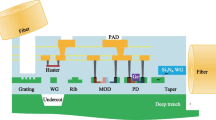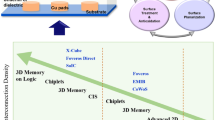Abstract
In the nanoscale regime, carbon nanotubes (CNTs) are being considered as a future alternative interconnect material for traditional copper (Cu) wires in integrated circuit technology. The advances in device scaling and the continuous increase of clock frequencies in very large-scale integration technology have resulted in signal integrity (SI) issues. The reduction of such SI issues in coupled multiwalled CNT bundle interconnects is evaluated herein. The worst-case crosstalk delay and peak noise voltage are simulated for three-line coupled interconnects at the 22-nm technology node. To minimize the crosstalk effects, a passive shielding technique is proposed, resulting in reductions of 15.3% and 40.8% in the dynamic in-phase and out-phase crosstalk condition, respectively. The SI of single- and two-line coupled MWCNT bundle interconnects is also investigated based on eye diagrams in a channel simulator and compared with that of Cu interconnects. The eye-opening height is significantly enhanced in the MWCNT bundle and Cu interconnects when using the proposed technique. Moreover, the MWCNT bundle has a higher eye-opening compared with its Cu counterpart.












Similar content being viewed by others
References
Engelhardt, M., Traving, M., Steinhögl, W., Steinlesberger, G., Schindler, G.: Comprehensive study of the resistivity of copper wires with lateral dimensions of 100nm and smaller. J. Appl. Phys. 97(2), 023706 (2005)
Zhang, J., Friedman, E.G.: Crosstalk modeling for coupled RLC interconnects with application to shield insertion. IEEE Trans. Very Large Scale Integr. Syst. 14(6), 641–646 (2006)
Vittal, A., Marek-Sadowska, M.: “Crosstalk reduction for VLSI. IEEE Trans. Comput. Des. Integr. Circuits Syst. 16(3), 290–298 (1997)
Noise, S., Salman, E., Friedman, E.G.: Shielding methodologies in the presence of power/ground noise. Techniques 19(8), 1–11 (2011)
Kumar, M.G., Agrawal, Y., Chandel, R.: Carbon nanotube interconnects—a promising solution for VLSI circuits. IETE J. Educ. 57(2), 46–64 (2016)
Tang, M., Mao, J.: Modeling and fast simulation of multi-walled carbon nanotube interconnects. IEEE Trans. Electromagn. Compat. 57(2), 232–240 (2015)
Li, H., Xu, C., Srivastava, N., Banerjee, K.: Carbon nanomaterials for next-generation interconnects and passives: physics, status, and prospects. IEEE Trans. Electron Devices 56(9), 1799–1821 (2009)
Agrawal, Y., Kumar, M.G., Chandel, R.: Comprehensive model for high-speed current-mode signaling in next generation MWCNT bundle interconnect using FDTD technique. IEEE Trans. Nanotechnol. 15(4), 590–598 (2016)
Nihei, M., et al.: Low-resistance multi-walled carbon nanotube vias with parallel channel conduction of inner shells. In: Proceedings of the Interconnect Technollgy Conference, pp. 234–236 (2005)
Kumar, A., Kumar, V.R., Kaushik, B. K.: Transient analysis of crosstalk induced effects in mixed CNT bundle interconnects using FDTD technique. IEEE Trans. Electromagne. Compat. 61(5), 1621–1629 (2019). https://doi.org/10.1109/TEMC.2018.2872899
Kreupl, F., Graham, A., Duesberg, G., Steinhögl, W., Liebau, M., Unger, E., Hönlein, W.: Carbon nanotubes in interconnect applications. Microelectron. Eng. 64(1–4), 399–408 (2002)
Sarto, M.S., Tamburrano, A.: Single-conductor transmission-line model of multiwall carbon nanotubes. IEEE Trans. Nanotechnol. 9(1), 82–92 (2010). https://doi.org/10.1109/tnano.2009.2023516
Li, H., Yin, W., Banerjee, K., Mao, J.: Circuit modeling and performance analysis of multi-walled carbon nanotube interconnects. IEEE Trans. Electron Devices 55(6), 1328–1337 (2008). https://doi.org/10.1109/TED.2008.922855
Rossi, D., Cazeaux, J.M., Metra, C., Lombardi, F.: Modeling crosstalk effects in CNT bus architectures. IEEE Trans. Nanotechnol. 6(2), 133–145 (2007)
D’Amore, M., Sarto, M.S., Tamburrano, A.: Transient analysis of crosstalk coupling between high-speed carbon nanotube interconnects. In: Proceedings of the Interantional Symposium on Electromagneic Compatiability, Detroit, MI, pp. 18–22 (2008)
Pu, S.N., Yin, W.-Y., Mao, J.-F., Liu, Q.H.: Crosstalk prediction of single- and double-walled carbon-nanotube (SWCNT/DWCNT) bundle interconnects. IEEE Trans. Electron. Devices 56(4), 560–568 (2009)
D’Amore, M., Sarto, M.S., Tamburrano, A.: Fast transient analysis of next-generation interconnects based on carbon nanotubes. IEEE Trans. Electromagn. Compat. 52(2), 496–503 (2010). https://doi.org/10.1109/TEMC.2010.2045383
Liang, F., Wang, G., Lin, H.: Modeling of crosstalk effects in multiwall carbon nanotube interconnects. IEEE Trans. Electromagn. Compat. 54(1), 133–139 (2012)
Rossi, D., Cazeaux, J.M., Metra, C., Lombardi, F.: Modeling crosstalk effects in advanced CNT bus architectures. IEEE Trans. Nanotechnol. 6(2), 133–145 (2007)
Li, X.C., Mao, J.F., Swaminathan, M.: Transient analysis of CMOS-gate-driven RLGC interconnects based on FDTD. IEEE Trans. Comput. Des. Integr. Circuits Syst. 30(4), 574–583 (2011)
Kumar, V.R., Kaushik, B.K., Patnaik, A.: An accurate FDTD model for crosstalk analysis of CMOS-gate-driven coupled RLC interconnects. IEEE Trans. Electromagn. Compat. 56(5), 1185–1193 (2014)
Sato, S., et al.: Novel approach to fabricating carbon nanotube via interconnects using size-controlled catalyst nanoparticles. In: Proceedings of the Interconnect Technollgy Conference, pp. 230–232 (2006).
Arunachalam, R., Acar, E., Nassif, S.R.: Optimal shielding/spacing metrics for low power design. In: Proceedings of the IEEE Computer Society Annual Symposium on VLSI, pp. 167–172 (2003)
Kaul, H., Sylvester, D., Blaauw, D.: Active shields: a new approach to shielding global wires. In: Proceedings of the 12th ACM Great Lakes Symposium on VLSI, pp. 112–117 (2002). https://doi.org/10.1145/505306.505331
Becer, M.R., Blaauw, D., Zolotov, V., Panda, R., Hajj, I.N.: Analysis of noise avoidance techniques in DSM interconnects using a complete crosstalk noise model. In: Proceedings 2002 Design, Automation and Test in Europe Conference and Exhibition, pp. 456-463 (2002). https://doi.org/10.1109/DATE.2002.998313
Buses, L.O., Ghoneima, M., Ismail, Y.I., Khellah, M.M., Tschanz, J.W., De, V.: Formal derivation of optimal active shielding for. Comput. Des. 25(5), 821–836 (2006)
Karthikeyan, A., Mallick, P.S.: Optimization techniques for CNT based VLSI Interconnects—a review. J. Circuits Syst. Comput. (2017). https://doi.org/10.1142/s0218126617300021
Becer, M.R., Blaauw, D., Zolotov, V., Panda, R., Hajj, I.N.: Analysis of noise avoidance techniques in DSM interconnects using a complete crosstalk noise model. In: Proceedings 2002 Design, Automation and Test in Europe Conference and Exhibition, pp. 456–463 (2002)
Zhang, J., Friedman, E.G.: Effect of shield insertion on reducing crosstalk noise between coupled interconnects. In: 2004 IEEE International Symposium on Circuits and Systems (IEEE Cat. No.04CH37512), Vancouver, BC, pp. II-529 (2004). https://doi.org/10.1109/ISCAS.2004.1329325.
Rezaei Khezeli, M., Moaiyeri, M.H., Jalali, A.: Analysis of crosstalk effects for multiwalled carbon nanotube bundle interconnects in ternary logic and comparison with Cu interconnects. IEEE Trans. Nanotechnol. 16(1), 107–117 (2017). https://doi.org/10.1109/TNANO.2016.2633460
Li, H.J., Lu, W.G., Li, J.J., Bai, X.D., Gu, C.Z.: Multichannel ballistic transport in multiwall carbon nanotubes. Phys. Rev. Lett. 95, 086601–086604 (2005)
Sahoo, M., Ghosal, P., Rahaman, H.: Modeling and analysis of crosstalk induced effects in multiwalled carbon nanotube bundle interconnects: an ABCD parameter-based approach. IEEE Trans. Nanotechnol. 14(2), 259–274 (2015). https://doi.org/10.1109/TNANO.2014.2388252
Pop, E., Mann, D., Goodson, K., Dai, H.: Electrical and thermal transport in metallic single-wall nanotubes on insulating substrates. J Appl Phys. 101(9), 1093710-1093710–10 (2007)
Nieuwoudt, A., Massoud, Y.: On the optimal design, performance, and reliability of future carbon nanotube-based interconnect solutions. IEEE Trans. Electron. Devices 55(8), 2097–2110 (2008). https://doi.org/10.1109/TED.2008.926733
Das, D., Rahaman, H.: Crosstalk overshoot/undershoot analysis and its impact on gate oxide reliability in multi-wall carbon nanotube interconnects. J. Comput. Electron. 10(4), 360–372 (2011)
Zhang, J., Friedman, E.G.: Mutual inductance modeling for multiple RLC interconnects with application to shield insertion. In: Proceedings of the IEEE International SOC Conference, Santa Clara, CA, USA, pp. 344–347 (2004). https://doi.org/10.1109/SOCC.2004.1362457
International Technology Roadmap for Semiconductors, (2013) [Online]. http://public.itrs.net
Kumar, V.R., Kaushik, B.K., Patnaik, A.: Crosstalk noise modeling of multiwall carbon nanotube (MWCNT) interconnects using finite-difference time-domain (FDTD) technique. Microelectron. Reliab. 55(1), 155–163 (2015)
Predictive Technology Models (2015) [Online]. http://ptm.asu.edu
Ghoneima, M., Ismail, Y.I., Khellah, M.M., Tschanz, J.W., De, V.: Formal derivation of optimal active shielding for low-power on-chip buses. IEEE Trans. Comput. Aided Des. Integr. Circuits Syst. 25(5), 821–836 (2006). https://doi.org/10.1109/TCAD.2005.855974
Hall, S.H., Heck, H.L.: Advanced Signal Integrity for High-Speed Digital Designs. Wiley, IEEE (2009)
Wu, T., Buesink, F., Canavero, F.: Overview of signal integrity and EMC design technologies on PCB: fundamentals and latest progress. IEEE Trans. Electromagn. Compat. 55(4), 624–638 (2013). https://doi.org/10.1109/TEMC.2013.2257796
Sanders, A., Resso, M, Ambrosia, J.D.: Channel compliance testing utilizing novel statistical eye methodology. In: Design Con (2004)
Acknowledgements
This research has been supported by the Visvesvaraya Ph.D. scheme, MeitY, Govt. of India. MEITY-PHD-1898. The research grants file number is PhD-MLA-4(63)/2015-16. The authors would like to thank the Principal, University College of Engineering, and Osmania University for support.
The authors also thank the reviewers for suggesting revisions to this paper.
Author information
Authors and Affiliations
Corresponding author
Additional information
Publisher’s Note
Springer Nature remains neutral with regard to jurisdictional claims in published maps and institutional affiliations.
Rights and permissions
About this article
Cite this article
Mudavath, R., Bhukya, R.N. & Jeripotula, P.R. The mitigation of signal integrity issues in coupled MWCNT bundles and a comparison with Cu interconnects. J Comput Electron 20, 1430–1438 (2021). https://doi.org/10.1007/s10825-021-01684-w
Received:
Accepted:
Published:
Issue Date:
DOI: https://doi.org/10.1007/s10825-021-01684-w




